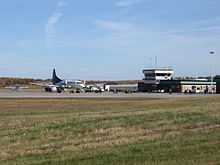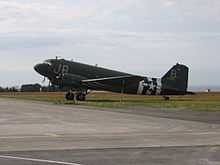Mont-Joli Airport
| Mont-Joli Airport | |||
|---|---|---|---|
 | |||
| IATA: YYY – ICAO: CYYY – WMO: 71718 | |||
| Summary | |||
| Airport type | Public | ||
| Operator | Régie Intermunicipale | ||
| Location | Mont-Joli, Quebec | ||
| Time zone | EST (UTC−05:00) | ||
| • Summer (DST) | EDT (UTC−04:00) | ||
| Elevation AMSL | 172 ft / 52 m | ||
| Coordinates | 48°36′32″N 068°12′27″W / 48.60889°N 68.20750°WCoordinates: 48°36′32″N 068°12′27″W / 48.60889°N 68.20750°W | ||
| Map | |||
 CYYY | |||
| Runways | |||
| Direction | Length | Surface | |
| ft | m | ||
| 06/24 | 5,000 | 1,524 | Asphalt |
| 15/33 | 3,954 | 1,205 | Asphalt |
| Statistics (2010) | |||
| Aircraft movements | 5,798 | ||
| Sources: Canada Flight Supplement[1] Environment Canada[2] Movements from Statistics Canada[3] | |||
Mont-Joli Airport (IATA: YYY, ICAO: CYYY) is located 1.5 nautical miles (2.8 km; 1.7 mi) north northwest of Mont-Joli, Quebec, Canada.
History


In the summer of 1940 the Royal Canadian Air Force selected a flat area of farmland between Mont-Joli Station (on the Montreal-Halifax Canadian National Railway mainline) and the Saint Lawrence River for a military airfield. Construction on the aerodrome began in October 1941 and was completed by April 1942 at a cost of $200,000. Three paved runways and 50 buildings were constructed for what became known as RCAF Station Mont-Joli.
Inaugurated on April 15, 1942, RCAF Station Mont-Joli was used as part of the British Commonwealth Air Training Plan for a bombing and gunnery school until the end of World War II. Less well-known was RCAF Station Mont-Joli's critical role during the Battle of the St. Lawrence when RCAF Eastern Air Command used it as a coastal patrol base; during 1942-1944, dozens of Canadian cargo and warships were sunk by German U-boats in an effort to close the critical Saint Lawrence Seaway off to shipping. Aircraft staging out of Mont-Joli were crucial to warding off U-boats and ensuring the safety of shipping out to the eastern tip of the Gaspé Peninsula at Cap-Gaspé.
RCAF Station Mont-Joli was decommissioned by the air force in 1945 and became the property of the Department of Transport (now Transport Canada) on December 15, 1945 for use as a civilian airport, and its ownership was transferred in 1995 to the "Régie intermunicipale de l’aéroport régional de Mont-Joli". It is the busiest airport in eastern Quebec, though still very far from the Québec/Jean Lesage International Airport in Quebec City and Montréal-Pierre Elliott Trudeau International Airport in Montreal.
In 2007 a second runway (15/33) was opened and the 06/24 runway decreased in length from 6,000 ft (1,829 m) to 5,000 ft (1,524 m).
Airlines and destinations
| Airlines | Destinations |
|---|---|
| Air Canada Express operated by Jazz Air | Baie-Comeau, Montreal-Trudeau |
| Pascan Aviation | Bonaventure, Havre Saint-Pierre, Happy Valley-Goose Bay, Îles-de-la-Madeleine, Montréal-Saint-Hubert, Quebec City, Rouyn-Noranda, Sept-Îles, Val-d'Or, Wabush |
References
- ↑ Canada Flight Supplement. Effective 0901Z 12 December 2013 to 0901Z 6 February 2014
- ↑ Synoptic/Metstat Station Information
- ↑ Total aircraft movements by class of operation — NAV CANADA flight service stations
External links
| Wikimedia Commons has media related to Mont-Joli Airport. |
- Past three hours METARs, SPECI and current TAFs for Mont-Joli Airport from Nav Canada as available.
| |||||||||||||||||||||||